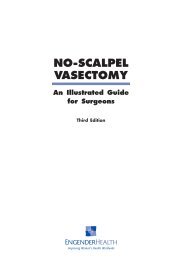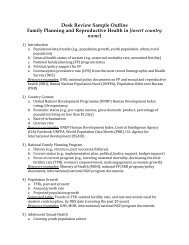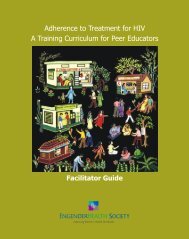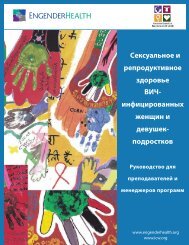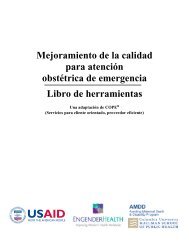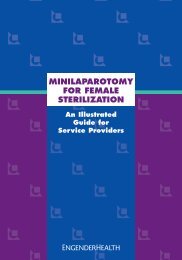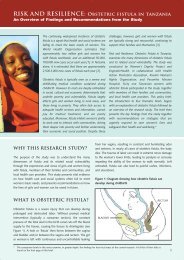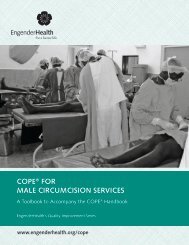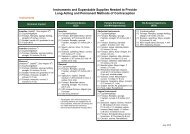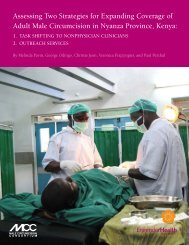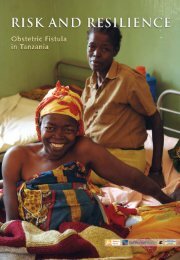Help-Seeking Pathways and Barriers for ... - EngenderHealth
Help-Seeking Pathways and Barriers for ... - EngenderHealth
Help-Seeking Pathways and Barriers for ... - EngenderHealth
Create successful ePaper yourself
Turn your PDF publications into a flip-book with our unique Google optimized e-Paper software.
enjoyable <strong>for</strong> participants. Such PFGs provide study participants with a <strong>for</strong>um to reflect upon<br />
the risks <strong>and</strong> realities that are present in their communities. They have been used by<br />
various disciplines to harness the voices of marginalized <strong>and</strong> disenfranchised subpopulations.<br />
The ICRW team had previously applied these participatory research methods to<br />
explore sensitive topics including sexual violence <strong>and</strong> reproductive health risks in Tanzania. 8<br />
These techniques are increasingly recognized as effective strategies to actively engage<br />
participants (including marginalized/stigmatized groups <strong>and</strong> individuals with varying<br />
educational levels), <strong>and</strong> generally allow <strong>for</strong> a greater sense of ownership <strong>and</strong> collaboration<br />
in the research. In addition, by validating experiences, ideas, <strong>and</strong> opinions, the participatory<br />
discussions can be an empowering process <strong>for</strong> participants.<br />
For this study, PFGs were conducted with same sex <strong>and</strong> age groups (women 18-24 years,<br />
women 25 years+, men 18-24 years, men 25 years+) of 8-15 individuals in each of the<br />
three study sites. The sessions lasted an average of two hours per session. GBV survivors<br />
were not actively recruited <strong>for</strong> these discussions; however, given the prevalence of violence<br />
in the country, it is likely that individual survivors as well as friends <strong>and</strong> family members of<br />
survivors participated in the groups.<br />
Throughout the research process, the ICRW <strong>and</strong> UDSM teams strictly adhered to the WHO<br />
Safety <strong>and</strong> Ethical Guidelines <strong>for</strong> Researching Violence Against Women. All safeguards were<br />
taken to ensure the protection of research participants, as laid out in the research protocol<br />
approved by the ICRW’s Institutional Review Board <strong>and</strong> UDSM’s Directorate of Research <strong>and</strong><br />
Publications. Additionally, the protocol was reviewed by representatives of the Ministry of<br />
Health <strong>and</strong> Social Welfare (MoHSW), the <strong>EngenderHealth</strong> Monitoring <strong>and</strong> Evaluation team,<br />
<strong>and</strong> several PEPFAR implementing partners in Tanzania. Confidentiality, anonymity, <strong>and</strong> the<br />
avoidance of re-traumatization related to experiences of violence were emphasized in the<br />
protocol development, training of the research team, <strong>and</strong> throughout data collection <strong>and</strong><br />
analysis.<br />
Please see Annexes 2 <strong>and</strong> 3 <strong>for</strong> the Key In<strong>for</strong>mant Interview Guides <strong>and</strong> Annex 4 <strong>for</strong> the<br />
Participatory Focus Group Guide. 9<br />
B. Sample Description<br />
As set <strong>for</strong>th in the approved research protocol <strong>and</strong> in line with the programmatic priorities of<br />
the PEPFAR partners in Tanzania, the data collection was carried out in one urban <strong>and</strong> one<br />
rural district in each of the three targeted regions: Dar es Salaam, Iringa, <strong>and</strong> Mbeya. A<br />
stakeholders’ meeting was held prior to finalization of the district selection to solicit input<br />
from the key government agencies associated with GBV programming: MoHSW, MCDGC,<br />
<strong>and</strong> TACAIDS. Hence, the selection of the districts was made in consultation with GoT<br />
national representatives, regional Community Development Officers, <strong>and</strong> with reference to a<br />
8 See <strong>for</strong> example: McCleary-Sills, J., Douglas, Z., Rwehumbiza, A., Hamisi, A., & Mabala, R. (2011). Vijana<br />
Tunaweza Newala: Findings from a Participatory Research <strong>and</strong> Action Project in Tanzania. Washington, D.C.:<br />
International Center <strong>for</strong> Research on Women.<br />
9 These tools are included <strong>for</strong> illustrative purposes only. Training on the use of these methods developed by<br />
ICRW is strongly advised.<br />
<strong>Help</strong>-<strong>Seeking</strong> <strong>Pathways</strong> <strong>and</strong> <strong>Barriers</strong> <strong>for</strong> Survivors of GBV in Tanzania March 2013<br />
Page 14



